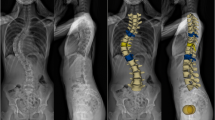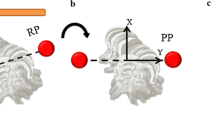Abstract
Objective
To use digital software to measure the morphologic and anatomic parameters of adolescent idiopathic scoliosis (AIS). Differences and correlations among different parameters were compared to provide an anatomic basis for the selection of treatment methods and preoperative evaluation of AIS.
Methods
Spinal radiographs were taken from 300 boys and girls (age, 10–18 years) suffering from idiopathic scoliosis in four grade-A hospitals in Inner Mongolia. After screening, 120 cases with complete imaging data were assessed. Imaging data were transferred to a work station (Dr Wise™). The anatomic indices of the Cobb Angle, CVA, AVT, TS, CA, CPT, CSI, FPT, CCA, TK, LL, SS, PT, and PI were measured.
Results
There were significant differences in AVT between different grades and types of scoliosis (F = 34.079, P = 0.000; χ2 = 23.379, P = 0.000). AVT was a protective factor, and the smaller the AVT, the less severe was the scoliosis. Compared with adolescents with mild or moderate scoliosis, the Cobb angle of adolescents with severe scoliosis was negatively correlated with CCA, LL, and SS (r = − 0.641, p < 0.05; r = − 0.695, p < 0.01; r = − 0.814, p < 0.01).
Conclusions
Some of the anatomic parameters in the coronal and sagittal planes of adolescents with idiopathic scoliosis were significantly different according to the severity and type of scoliosis. Significant correlations were found between more anatomic indices in adolescents with severe scoliosis than in adolescents suffering from mild or moderate scoliosis.




Similar content being viewed by others
Data availability
Additional data are not available.
Change history
08 April 2023
A Correction to this paper has been published: https://doi.org/10.1007/s00586-023-07645-0
References
Dunn J, Henrikson NB, Morrison CC, Blasi PR, Nguyen M, Lin JS (2018) Screening for adolescent idiopathic scoliosis: evidence report and systematic review for the US preventive services task force. JAMA 319(5):173–187
Lo YF, Huang YC (2017) Bracing in adolescent idiopathic scoliosis. Hu Li Za Zhi 64(2):117–123
Lenke LG (2001) Adolescent idiopathic scoliosis: a new classification to determine extent of spinal arthrodesis. J bone Joint Surg 83:1169–1181
Negrini S, Donzelli S, Aulisa AG, Czaprowski D, Schreiber S, de Mauroy JC, Diers H, Grivas TB, Knott P, Kotwicki T, Lebel A, Marti C, Maruyama T, O’Brien J, Price N, Parent E, Rigo M, Romano M, Stikeleather L, Wynne J, Zaina F (2018) 2016 SOSORT guidelines: orthopaedic and rehabilitation treatment of idiopathic scoliosis during growth. Scoliosis Spinal Disord 10(13):3
Castro FP Jr (2003) Adolescent idiopathic scoliosis, bracing, and the Hueter-Volkmann principle. Spine J 3(3):180–185
Chen RQ, Watanabe K, Hosogane N, Hikata T, Iwanami A, Ishii K, Nakamura M, Toyama Y, Matsumoto M (2013) Spinal coronal profiles and proximal femur bone mineral density in adolescent idiopathic scoliosis. Eur Spine J 22(11):2433–2437
Benlong S, Ziping L, Saihu M, Zhen L et al (2017) Cobb’s angle, thoracic kyphosis and lumbar lordosis in adolescent idiopathic scoliosis Supine MRI and standing Comparative study of X-ray measurement. Chin J Anatomy Clin Med 22(01):6–10
Ming Li, Chunhong Ni, Tiesheng H, etc. (2003) Trunk imbalance and its causes after idiopathic scoliosis surgery. Neck Low Back Pain Misc 24(6):327–330
Lee CF, Fong DY, Cheung KM, Cheng JC, Ng BK, Lam TP, Yip PS, Luk KD (2012) A new risk classification rule for curve progression in adolescent idiopathic scoliosis. Spine J 12(11):989–995
Pasha S (2021) The sagittal curvature of the spine can be a leading cause of scoliosis in pediatric spine. Stud Health Technol Inform 280(8):9–13
Pasha S (2019) 3D deformation patterns of S shaped Elastic rods as a pathogenesis model for spinal deformity in adolescent idiopathic scoliosis. Sci Rep 9(1):16485
Acaroglu E, Doany M, Cetin E, Castelein R (2019) Correction of rotational deformity and restoration of thoracic kyphosis are inversely related in posterior surgery for adolescent idiopathic scoliosis. Med Hypotheses 133:109396
Crijns TJ, Stadhouder A, Smit TH (2017) Restrained differential growth: the initiating event of adolescent idiopathic scoliosis? Spine 42(12):E726–E732
Dede O, Yazici M (2020) Restoring sagittal and frontal balance following posterior instrumented fusion. Ann Transl Med 8(2):30
Binhao C, Xiangyang W, Xibang C, Wang Yongli Xu, Huazi CY (2017) Characteristics of upper cervical sequence changes and the correlation between parameters in adolescent idiopathic scoliosis patients. Chin J Spinal Cord 27(02):130–135
Cochran T, Irstam L, Nachemson A (1983) Long-term anatomic and functional changes in patients with adolescent idiopathic scoliosis treated by Harrington rod fusion. Spine 8(6):576–583
Yagi M, Iizuka S, Hasegawa A et al (2014) Sagittal cervical alignment in adolescent id-iopathic scoliosis. Spine Deformity 2(2):122–130
Hilibrand AS, Tannenbaum DA, Graziano GP et al (1995) The sagittal alignment of the cervical spine in adolescent idiopathic scoliosis. J Pediatr Orthop 15(5):627–632
Canavese F, Turcot K, De Rosa V, de Coulon G, Kaelin A (2011) Cervical spine sagittal alignment variations following posterior spinal fusion and instrumentation for adolescent idiopathic scoliosis. Eur Spine J 20(7):1141–1148
Hu P, Yu M, Liu X, Zhu B, Liu X, Liu Z (2016) Analysis of the relationship between coronal and sagittal deformities in adolescent idiopathic scoliosis. Eur Spine J 25(2):409–416
Clément JL, Geoffray A, Yagoubi F, Chau E, Solla F, Oborocianu I, Rampal V (2013) Relationship between thoracic hypokyphosis, lumbar lordosis and sagittal pelvic parameters in adolescent idiopathic scoliosis. Eur Spine J 22(11):2414–2420
Ilharreborde B, Pesenti S, Ferrero E, Accadbled F, Jouve JL, De Gauzy JS, Mazda K (2018) Correction of hypokyphosis in thoracic adolescent idiopathic scoliosis using sublaminar bands: a 3D multicenter study. Eur Spine J 27(2):350–357
Han F, Weishi Li, Zhuoran S, Qingwei Ma, Zhongqiang C (2015) Spinal and pelvic sagittal imaging features of degenerative lumbar scoliosis. Chin J Spinal Cord 25(06):528–532+540
Schwab FJ, Blondel B, Bess S, Hostin R, Shaffrey CI, Smith JS, Boachie-Adjei O, Burton DC, Akbarnia BA, Mundis GM, Ames CP, Kebaish K, Hart RA, Farcy JP, Lafage V; International Spine Study Group (ISSG) (2013) Radiographical spinopelvic parameters and disability in the setting of adult spinal deformity: a prospective multicenter analysis. Spine 38(13): E803–E812
Zhang Ruifang (2015) Reliability evaluation of a new method for coronal trunk imbalance. Wenzhou Medical University, Dissertation
Jiawei He, Guanghui B, Zhihan Y et al (2007) Study on the evaluation method of coronal trunk imbalance. Tradit Chin Med 19(9):15–16
Scheer JK, Tang JA, Smith JS et al (2013) Cervical spine alignment, sagittal deformity, and clinical implications. J Neurosurg Spine 19(2):141–159
Yu M, Silvestre C, Mouton T et al (2013) Analysis of the cervical spine sagittal alignment in young idiopathic scoliosis: a morphological classification of 120 cases. Eur Spine J 22(11):2372–2381
Acknowledgements
Thank Baotou Central Hospital, The First Affiliated Hospital of Baotou Medical College, The Affiliated Hospital of Inner Mongolia Medical University, and The Second Affiliated Hospital of Inner Mongolia Medical University for their assistance. Thank you all doctors for your hard work, thank you engineers of AI Lab, Deepwise & League of PhD Technology for their full support.
Funding
This study was supported financially by the Science and Technology Project in Inner Mongolia, China (2019GG115), 2021 Zhiyuan Talent Project of Inner Mongolia Medical University, Innovation Team Development Plan of Inner Mongolia Education Department (NMGIRT2227), Inner Mongolia Natural Science Foundation (2020MS08124), Inner Mongolia “Grassland Talents” Youth Innovation and Entrepreneurship Talents Project (2020), Ulaanbaatar City Basic Research Project (2021JC321) and Inner Mongolia Medical University 2021 Annual Key Project of University-level Scientific Research (YKD2021ZD001), Joint project of Inner Mongolia Medical University (YKD2022LH039).
Author information
Authors and Affiliations
Contributions
WC finished the manuscript writing. WO is responsible for data aggregation and statistical analysis. XL gives direction to manuscript writing and submission. MG, JL, QL and ZK are responsible for data key point labeling. HW, ZL, XW, SZ, YZ, FJ and KZ are responsible for the collection, aggregation and data analysis of cases.
Corresponding author
Ethics declarations
Ethical approval
The study protocol was approved (YKD2019GG115) by the Ethics Committee of Inner Mongolia Medical University. Written informed consent was not required because this study was retrospective.
Conflict of interest
The authors of this manuscript declare no relationships with any companies whose products or services may be related to the subject matter of this article.
Additional information
Publisher's Note
Springer Nature remains neutral with regard to jurisdictional claims in published maps and institutional affiliations.
Rights and permissions
Springer Nature or its licensor (e.g. a society or other partner) holds exclusive rights to this article under a publishing agreement with the author(s) or other rightsholder(s); author self-archiving of the accepted manuscript version of this article is solely governed by the terms of such publishing agreement and applicable law.
About this article
Cite this article
Wu, C., Ou, W., Gao, M. et al. Digital measurement and correlation analysis of coronal and sagittal anatomic parameters in the radiographs of adolescent patients with idiopathic scoliosis. Eur Spine J 32, 1161–1172 (2023). https://doi.org/10.1007/s00586-023-07527-5
Received:
Accepted:
Published:
Issue Date:
DOI: https://doi.org/10.1007/s00586-023-07527-5




